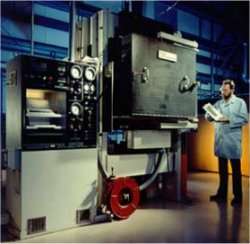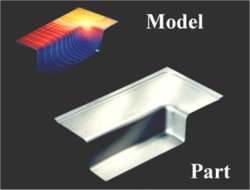Understanding the interplay of grains helps cars drop the pounds, be more fuel efficient

Sometimes solving the biggest challenges begins with understanding something very small -- like the tiny grains that form a piece of metal. For a team of scientists who wanted to improve automotive fuel efficiency, understanding and controlling the size of the grains in aluminum allowed the design of an easy and inexpensive method for producing lightweight automotive parts, replacing heavier steel, leading to improved fuel efficiency. This method is known as superplastic forming or SPF; the process relies on a tailor-made metal that can stretch into a complex shape, such as a trunk lid. The process was not used for car components because of the expensive additives and complicated processes required to create the appropriate aluminum alloy.
The problem is the grain size. You need small grains that stay small while you form the aluminum. Through careful research, the scientists determined an inexpensive way to keep the grains small, and the industrial partners took that knowledge and created a process that works on the large scale.
Developed through a partnership among the Department of Energy, General Motors Corporation, Pacific Northwest National Laboratory, and others, SPF replaces heavy steel with lightweight aluminum, without sacrificing safety. In SPF, a metal alloy is heated and clamped against a hot die of the desired shape, such as a trunk lid or an inner support structure of a hood. When sheet metal softens, it stretches easily, like dough draping into a pie pan. Pressurized gas is used to stress the metal and make it stretch against the lubricated mold.
"The breakthrough was discovering how grain size and composition in aluminum alloy affect the superplastic metal forming process," said Greg Exarhos, who coordinates PNNL's material science program suite.
"We tailored an expensive process to be usable in high-volume manufacturing with an affordable material," said Ken Johnson, Pacific Northwest National Laboratory.

Metals are composed of grains, technically crystals. The size, orientation, and distribution of these crystals and the boundaries between the crystals change as a metal goes from ore to product. To create a material capable of superplastic forming, it needs to have small grains that can easily slide past each other when the metal is stretched.
In SPF, the small grains simply slide pasteach other, allowing the metal to stretch without creating defects. The grains have to be made small and kept small, even when the material is heated.
Fundamental research at the national laboratory was focused on the dynamic, interfacial processes that control how grains nucleate, grow, and move inside metals during deformation. The scientists examined grain boundary sliding and superplastic deformation. Interactions between grains were measured and modeled. The researchers examined defects during sliding of different sections in key aluminum alloy systems. This basic science provided key insights into the microstructure and microchemistry controlling grain boundary sliding.
Understanding the behavior of these grains and other components of the alloy has allowed the design of thermomechanical processing routes to manipulate the microstructure of the metal and, hence, the superplastic behavior of the alloy. Not only is the extent of elongation important in these materials, but also the magnitude of the strain rate required to achieve that elongation. This has implications for how quickly one can deform the material.
Strain rate is a measure of how fast the metal is stretching, and superplastic behavior occurs in a range of strain rates where the metal can stretch much farther than it can at room temperature. This "sweet spot" in the strain rate can only be achieved by continually changing the gas pressure as the shape of the part changes to take on the shape of the die.
"The SPF challenge is a lot like pulling taffy," said Ken Johnson, a scientist at PNNL who worked on the project. "If you pull too slow, you are wasting time. If you pull too fast, it breaks." The trick is finding the sweet spot and reaching that spot as quickly and cheaply as possible.

The journey from academic curiosity to mass production began for SPF in the early 1990s. The adventure began, as so many often do, with the convergence of ideas and innovation. General Motors and the Department of Energy wanted to find a way to reduce the weight of automobiles to increase the fuel efficiency. PNNL had experience in a process that could produce lightweight materials. Kaiser Aluminum understood metals and had the right industrial experience.
"I believe that this is a great example of how a national lab can bring together a team of industrial partners to solve an important problem," said Bruce Harrer, who coordinated the efforts of the SPF project from the earliest days.
The unique partnership would eventually result in PNNL, General Motors, Kaiser Aluminum and code developer MARC Analysis being recognized for their roles in SPF with a Federal Laboratory Consortium Technology Transfer Award in 2000.
"But, it wouldn't have happened without different offices within the Department of Energy working together," said Harrer, who made the initial funding connections and tended to those ties over the project's duration. "DOE's Laboratory Technology Research program funded improvements to the model. Then, DOE's Office of Energy Efficiency and Renewable Energy funded the parallel experimental work. This was soon augmented by a project—from DOE's Basic Energy Sciences—to study fundamental processes in materials deformation. Superplastic forming showcases how individual offices and programs within DOE can work together to make a solution possible."
Researchers modified an existing code to calculate the optimum stress for the SPF process. Combining the simulations and the basic understanding of the size and behavior of aluminum grains, PNNL worked with Kaiser Aluminum to create an alloy with small amounts of magnesium, manganese, chromium, silicon, iron, and titanium.
By working on the metals at the same time as the computer software, the team was able to take an iterative approach to the challenges at hand, bringing together what they learned by running the model and what they learned in the laboratory. For example, the team found that materials data on the metal elasticity was not as accurate as they needed. Careful study showed that the size of metal samples being stretched influenced the data. Metal flowing from the grip ends of the samples was actually interfering with the stress and strain rate measurements. The team repeated previous studies with samples that were twice as long and achieved much more accurate materials data.
The iterative nature between the model and the laboratories was also seen in more day-to-day interactions. When a promising metal was created, calculations were run to determine the right operating conditions. Then the new sheet metal formulation was tested in the SPF press at PNNL. At the end of the project, the team provided the specifications on the metal and an envelope of operating conditions, essentially recipes for preparing different shapes at different conditions.
The research catalyzed thinking within General Motors to actively pursue hot-blow forming of aluminum as a mainstream metal working technique. Following additional development work, General Motors developed a process with an order-of-magnitude reduction in cycle time. The process was used to produce complex components, including the hatchback on the Chevy Malibu Maxx, where the process cut the weight of the rear hatchback door nearly in half, from 39 pounds to 20 pounds. The process was also used on the Oldsmobile Aurora and the Cadillac STS.
More information: Publications: Vetrano JS, CA Lavender, CH Hamilton, MT Smith, and SM Bruemmer. 1994. "Superplastic Behavior in a Commercial 5083 aluminum alloy." Scripta Materialia 30, 565-570.
Johnson KI, MA Khaleel, CA Lavender, SG Pitman, JT Smith, MT Smith, and CH Hamilton. 1994. "The Effect of Specimen Geometry on the Accuracy of Constitutive Relations in a Superplastic 5083 Aluminum Alloy." Proceedings of the 1994 International Conference on Superplasticity in Advanced Materials, (ICSAM-94), May 24-26, 1994. Moscow, Russia.
Johnson KI, MA Khaleel, CA Lavender, and MT Smith. 1995. "Accuracy Issues in Modeling Superplastic Metal Forming." Proceedings of the Conference on Superplasticity and Superplastic Forming at the 124th Annual Meeting of The Minerals, Metals, and Materials Society (TMS), Las Vegas, NV, February 13-15, 1995. TMS, Warrendale, Pennsylvania.
Khaleel MA, KI Johnson, CA Lavendar, MT Smith, and CH Hamilton. 1996. "Specimen geometry effect on the accuracy of constitutive relations in a superplastic 5083 aluminum alloy." Scripta Materialia 34, 1417-1423.
Vetrano JS, SM Bruemmer, LM Pawlowski, and IM Robertson. 1997. "Influence of the Particle Size on Recrystallization and Grain Growth in Al-Mg-X Alloys." Materials Science and Engineering A238, 101.
Khaleel, MA, MT Smith, and SG Pitman. 1997. "The effect of strain rate history on the ductility in superplastic AA-5083." Scripta Materialia 37(12):1909-1915.
Khaleel MA, KI Johnson, CH Hamilton, and MT Smith. 1998. "Deformation modeling of superplastic AA-5083." International Journal of Plasticity 14, 1133-1154.
Khaleel MA, HM Zbib, and EA Nyberg. 2001. "Constitutive modeling of deformation and damage in superplastic materials." International Journal of Plasticity 17, 277-296.
Taylor MB, HM Zbib, and MA Khaleel. 2002. "Damage and size effect during superplastic deformation." International Journal of Plasticity 18, 415-442.
Davies TW, JS Vetrano, MT Smith, and SG Pitman. 2002. "Mechanical properties of aluminum tailor welded blanks at superplastic temperatures." Journal of Materials Processing Technology 128, 38-47.
Provided by Pacific Northwest National Laboratory
















